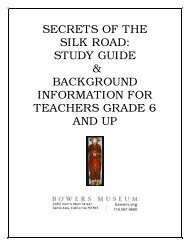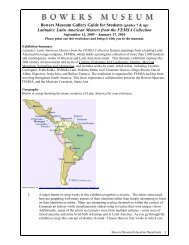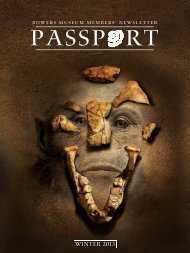A Resource Guide for Students and Teachers - Bowers Museum
A Resource Guide for Students and Teachers - Bowers Museum
A Resource Guide for Students and Teachers - Bowers Museum
Create successful ePaper yourself
Turn your PDF publications into a flip-book with our unique Google optimized e-Paper software.
decree, plaque, scale weight,<br />
mold, ceremonial, percussion,<br />
gilding, dagger, mechanism,<br />
helmet, armor, fragment, torso,<br />
archaeology, site, pigment,<br />
archer, civilian, infantry, acrobat,<br />
official, general<br />
The following materials are<br />
represented in the exhibit. Tell the<br />
students to look <strong>for</strong> artifacts made<br />
from each resource <strong>and</strong> list it next to<br />
each.<br />
bronze<br />
clay – terra cotta<br />
jade<br />
wood<br />
gold<br />
turquoise<br />
gilt bronze with shell inlay<br />
bronze inlaid with silver <strong>and</strong> gold<br />
limestone<br />
bamboo<br />
iron<br />
stone<br />
The following weapons are found<br />
in the exhibit:<br />
spear, lance, sword, arrow,<br />
crossbow, halberd, dagger, axe<br />
Natural <strong>Resource</strong>s Post Activity:<br />
After their visit to the exhibit,<br />
refer to the list of artifacts filled in at<br />
the exhibit on their list of resources.<br />
Discuss the resources <strong>and</strong> their uses.<br />
Discuss how these same objects are<br />
made today. Discuss the use of plastic<br />
26 TERRA COTTA WARRIORS<br />
to make many products. What are<br />
plastics made of?<br />
Research the history of jade. See<br />
bibliography.<br />
9. Chinese Calligraphy<br />
While at the Terra Cotta Warriors:<br />
Guardians of China’s First Emperor<br />
exhibit, students may observe <strong>and</strong><br />
practice Chinese calligraphy. Discuss<br />
with the students that Chinese<br />
characters are very different from<br />
the phonetic English language.<br />
Each Chinese character represents<br />
a syllable <strong>and</strong> also has a meaning.<br />
Chinese characters are made with<br />
brush strokes <strong>and</strong> look like drawings.<br />
See sample below.<br />
The symbols originally were<br />
pictures of people, animals, <strong>and</strong> other<br />
things but over the centuries these are<br />
no longer recognizable.<br />
Although there are about 80,000<br />
characters, only about 3,500 are<br />
commonly used. Each character<br />
takes the same amount of space no<br />
matter how complicated it is. There<br />
are no spaces between the characters<br />
so the reader has to figure out which<br />
syllables go together.<br />
http://www.omniglot.com/writing/<br />
chinese_evolution.htm<br />
10. What is Art?<br />
Class Discussion: What is art? “Art”<br />
is a very difficult word to define, <strong>and</strong><br />
everyone can have their own opinion<br />
of what they think it means. Does art<br />
have more to do with the actual item,<br />
the intention of its creation, or the<br />
ability of the creator? Try to come to<br />
a class consensus of what is art. Then<br />
create a class consensus of how the art<br />
in the exhibit can be critiqued.<br />
The exhibit presents a good<br />
opportunity to think about the<br />
differences between art <strong>and</strong><br />
something that is just utilitarian.<br />
During their visit to the museum,<br />
ask the students to think about their<br />
definition of art <strong>and</strong> whether the<br />
artifacts are art or not. Since the<br />
warriors were created <strong>for</strong> something<br />
rather than an aesthetic purpose,<br />
are they art? Note the beauty of the<br />
warriors <strong>and</strong> their design. After the<br />
class visits the exhibition, show the<br />
class their answers to “What is Art?”<br />
<strong>and</strong> ask if they still feel the same way<br />
they did be<strong>for</strong>e the visit. Have their<br />
opinions changed? How is the culture<br />
of ancient China represented in the<br />
artifacts found in the pits <strong>and</strong> tomb?<br />
Have the students imagine that<br />
they are creating a set of items they<br />
wish to accompany them in the<br />
afterlife. List the items <strong>and</strong> tell why.<br />
If their items were found 2,000 years<br />
from now, would people consider their<br />
artifacts art?<br />
The exhibit reflects art at the<br />
time of the Qin Dynasty. Show the<br />
students several samples of modern<br />
art. (A pre-activity can be <strong>for</strong> students<br />
to bring a picture from home of a<br />
piece of modern art to be used in this<br />
discussion, or the art teacher can be<br />
involved in the selection of artwork.)<br />
Just as the terra cotta warriors told us<br />
much about life during the time of<br />
the Qin Dynasty, what does modern<br />
art tell us about life today?<br />
The warriors were created<br />
to “protect” the First Emperor<br />
throughout eternity. Give each student<br />
a ball of clay. Have them create their<br />
own personal protector. Write <strong>and</strong><br />
discuss their choice of protector. Is it<br />
an animal? A specific person? Do they<br />
consider their statue a work of art?<br />
Why or why not?<br />
As an extension, students may<br />
research <strong>and</strong> share the definition of<br />
art with the class. They will find many<br />
definitions. Encourage them to choose<br />
their favorite <strong>and</strong> tell why.<br />
11. Chinese Symbolism<br />
The Chinese use various animal-like<br />
symbols in much of their art <strong>and</strong><br />
decorations. These symbols represent<br />
virtues <strong>and</strong> wishes of good <strong>for</strong>tune.<br />
For instance, a dragon is an example<br />
of a symbol believed to ward off<br />
evil spirits <strong>and</strong> lightening. Cranes<br />
symbolize longevity, a long life.<br />
Much symbolism was used in<br />
artwork in ancient China as well as<br />
today. Be<strong>for</strong>e coming to the exhibit,<br />
have the students research Chinese<br />
symbolism <strong>and</strong> then look <strong>for</strong> these<br />
symbols in the exhibit.<br />
At the exhibit the students will<br />
see examples of decorated roof tiles<br />
with Chinese symbols. The Chinese<br />
believed that the roof of a building<br />
was a l<strong>and</strong>ing plat<strong>for</strong>m where spirits<br />
connected with the human world.<br />
The roof slanted upwards in order<br />
to send evil spirits back to heaven.<br />
Roof decorations were utilized to help<br />
communicate with the spirits in order<br />
to attract good <strong>for</strong>tune, blessings <strong>and</strong><br />
protection.<br />
Activity:<br />
Have the students research Chinese<br />
symbolism <strong>and</strong> create a drawing or<br />
clay model of their own roof tile to use<br />
to protect their own home.<br />
12. Preserving Artifacts<br />
Class discussion: While at the<br />
museum, the students were asked





